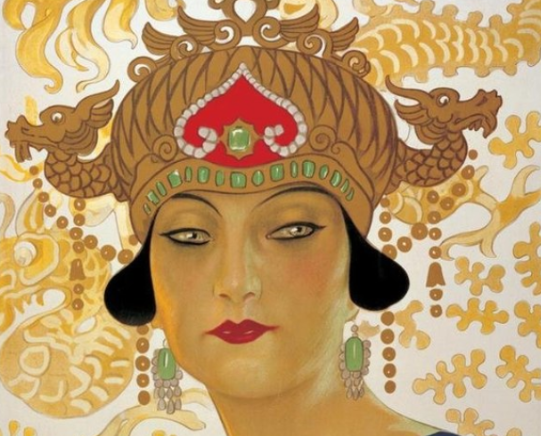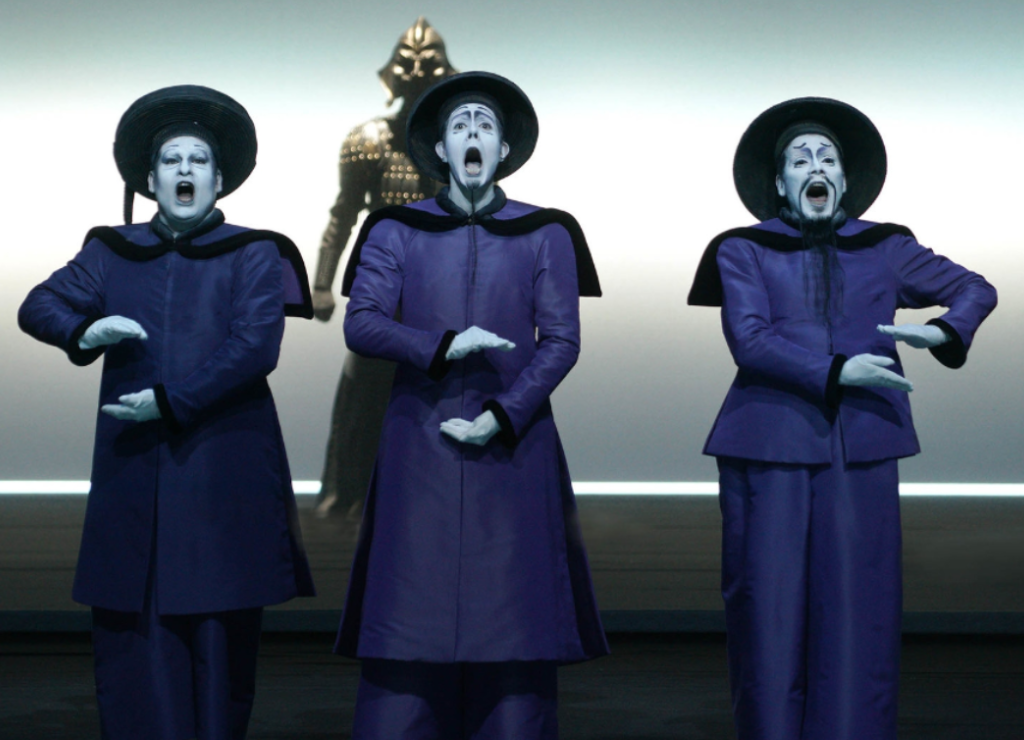
The story of Turandot
Reading Time: 6 minutes.
Introduction
Italian composer Giacomo Puccini (1858-1924) remains a fixture on international stages with his operas, but some of his works, such as Turandot and Madama Butterfly, are increasingly under scrutiny because of contemporary (postcolonial) sensitivities around cultural representation. The origins of the Turandot story lie in a 1752 Venetian play based on Persian tales by Italian playwright Carlo Gozzi (1720-1806), set in an imaginary China of the 10th, 11th century. Puccini worked on Turandot beginning in 1920, but he died in 1924 before he could complete the final act. The composer Franco Alfano (1875-1954) finalized the work based on the sketches Puccini had left behind. The piece fits into the commedia dell’arte tradition and is pure fantasy. Yet it was long banned in China, as its stereotypical and exotic portrayal of Asia was poorly received and Chinese people felt they were being portrayed as barbarians – think of the main character Turandot, the princess who embodies cruelty and cold-bloodedness, thus reinforcing the idea that Chinese princes would be barbaric.
The story
Set in a fairy-tale, mythical China, Puccini’s story follows Princess Turandot, who is determined never to marry. This determination stems from the fate of her ancestor, Princess Lo-u-Ling, who had to suffer severely after her kingdom was conquered. In revenge, Turandot gives all her suitors three puzzling tasks. Those who fail not only lose their chance at her hand, but also their lives. However, this does not deter Calaf, a Tartar prince in exile. He fell in love with Turandot after catching a glimpse of her through a window. Despite admonitions from his father – the exiled Tartar king – and the warning of Liu, the slave girl who is secretly in love with him, he strikes a huge gong, signaling his intention to compete for Turandot’s hand. After a lot of vicissitudes, Calaf defeats Turandot and the princess must give in. Meanwhile, the pathetic Liu is dead by her own hand after sacrificing herself to protect Calaf. Moved by Liu’s example, Turandot gives in to Calaf and drops her resistance to love, marriage and taming.
The caricatures
The three ministers in Turandot – Ping, Pong and Pang – are comic characters, but they also represent a deeper wisdom that refers to Taoist philosophy and Confucianism. Turandot does not exist, they sing at one point. She is simply nature in its workings. They warn Prince Calaf, that instead of trying to change the inexorably frozen heart of Turandot, who kills her suitors when they inevitably fail to solve her three riddles, he is better off just going with the flow. Take the loot, the women and the promise to rule other lands. She is only one woman and naked she looks like any other. That’s fairly cynical and fairly modern. To my ears, it also sounds universal and not tied to the Chinese context, though it does take root in Confucian philosophy, for instead of putting passion and personal ambition above all else, as Prince Calaf does, Confucianists would advocate choosing a path that promotes peace, stability and balance, both within oneself and in society. Ping, Pang and Pong offer a pragmatic approach: follow the natural course of things rather than going against the grain.
The controversy surrounding Turandot revolves mainly around the simplified and caricatured portrayal of Asian characters and themes that is perceived as offensive. The opera presents a distorted and simplistic picture of Chinese culture, which can lead to cultural misrepresentation and reinforcement of racist stereotypes. The use of yellowface, in which non-Asian actors color their skin and thus play the role of Asian characters, contributes to this issue and in a way does create clichéd images. Also, the cruel characterization of the princess Turandot, and the violent themes of death and punishment produce a negative image of Asian royalty.

Ping, Pong and Pang in Turandot performance by Robert Wilson (2023). Source: https://robertwilson.com/turandot.
Read more
Link to English-language article on Turandot, highlighting themes of cultural representation and the impact of orientalist imagery. Accessed 27/10/2024.
Link to English-language article from 2020, on the complex history and meanings of Puccini’s opera in both Chinese culture and Western interpretations.The Tao of ‘Turandot’: No escaping Puccini and ‘Nessun Dorma’ – Los Angeles Times (latimes.com). Accessed 27/10/2024.
Link to English-language article on Puccini’s two best-known works at artdaily.com. Accessed 27/10/2024.
Photo: Promotional poster for Giacomo Puccini’s opera “Turandot,” April 25, 1926. Source: Wikimedia Commons.
Alle auteurs
- DIS
- Advice from the doctor
- African poetry
- AIDS activism and gay emancipation
- Bibliography of Chris
- Bibliography of Olivier
- Biography of Chris
- Biography of Olivier
- Biography of Patrick
- Blogs
- Chris' Stage
- Columns
- Covid
- Dirk van Babylon Newsletter
- Double calling
- Essays
- Fragile light
- Hanna's Mind Wanderings
- Incapacity for work
- Late Pasquino's
- LEIF doctor
- Liechtensteiner
- Medical newsletter
- Memoirs of a general practitioner
- Miguel Molinos
- Moctines
- Musings
- Myriad
- Practice in Erembodegem
- Resignation
- Sleep problems
- Sonnets
- Sprawl Month
- Substance abuse and addiction
- Travel
- Uncategorized
- Vi to
- Vögels
- Voluntary euthanasia
- Weltschmerz
- Wormwood or The dose makes the poison
- kapper
- Advice from the doctor
- African poetry
- AIDS activism and gay emancipation
- Bibliography of Chris
- Bibliography of Olivier
- Biography of Chris
- Biography of Olivier
- Biography of Patrick
- Blogs
- Chris' Stage
- Columns
- Covid
- Dirk van Babylon Newsletter
- Double calling
- Essays
- Fragile light
- Hanna's Mind Wanderings
- Incapacity for work
- Late Pasquino's
- LEIF doctor
- Liechtensteiner
- Medical newsletter
- Memoirs of a general practitioner
- Miguel Molinos
- Moctines
- Musings
- Myriad
- Practice in Erembodegem
- Resignation
- Sleep problems
- Sonnets
- Sprawl Month
- Substance abuse and addiction
- Travel
- Uncategorized
- Vi to
- Vögels
- Voluntary euthanasia
- Weltschmerz
- Wormwood or The dose makes the poison
- Marforio
- Advice from the doctor
- African poetry
- AIDS activism and gay emancipation
- Bibliography of Chris
- Bibliography of Olivier
- Biography of Chris
- Biography of Olivier
- Biography of Patrick
- Blogs
- Chris' Stage
- Columns
- Covid
- Dirk van Babylon Newsletter
- Double calling
- Essays
- Fragile light
- Hanna's Mind Wanderings
- Incapacity for work
- Late Pasquino's
- LEIF doctor
- Liechtensteiner
- Medical newsletter
- Memoirs of a general practitioner
- Miguel Molinos
- Moctines
- Musings
- Myriad
- Practice in Erembodegem
- Resignation
- Sleep problems
- Sonnets
- Sprawl Month
- Substance abuse and addiction
- Travel
- Uncategorized
- Vi to
- Vögels
- Voluntary euthanasia
- Weltschmerz
- Wormwood or The dose makes the poison
- Michiel Hillen
- Advice from the doctor
- African poetry
- AIDS activism and gay emancipation
- Bibliography of Chris
- Bibliography of Olivier
- Biography of Chris
- Biography of Olivier
- Biography of Patrick
- Blogs
- Chris' Stage
- Columns
- Covid
- Dirk van Babylon Newsletter
- Double calling
- Essays
- Fragile light
- Hanna's Mind Wanderings
- Incapacity for work
- Late Pasquino's
- LEIF doctor
- Liechtensteiner
- Medical newsletter
- Memoirs of a general practitioner
- Miguel Molinos
- Moctines
- Musings
- Myriad
- Practice in Erembodegem
- Resignation
- Sleep problems
- Sonnets
- Sprawl Month
- Substance abuse and addiction
- Travel
- Uncategorized
- Vi to
- Vögels
- Voluntary euthanasia
- Weltschmerz
- Wormwood or The dose makes the poison
- Michiel Hillen; Chris Coolsma
- Advice from the doctor
- African poetry
- AIDS activism and gay emancipation
- Bibliography of Chris
- Bibliography of Olivier
- Biography of Chris
- Biography of Olivier
- Biography of Patrick
- Blogs
- Chris' Stage
- Columns
- Covid
- Dirk van Babylon Newsletter
- Double calling
- Essays
- Fragile light
- Hanna's Mind Wanderings
- Incapacity for work
- Late Pasquino's
- LEIF doctor
- Liechtensteiner
- Medical newsletter
- Memoirs of a general practitioner
- Miguel Molinos
- Moctines
- Musings
- Myriad
- Practice in Erembodegem
- Resignation
- Sleep problems
- Sonnets
- Sprawl Month
- Substance abuse and addiction
- Travel
- Uncategorized
- Vi to
- Vögels
- Voluntary euthanasia
- Weltschmerz
- Wormwood or The dose makes the poison
- Olivier Lichtenberg
- Advice from the doctor
- African poetry
- AIDS activism and gay emancipation
- Bibliography of Chris
- Bibliography of Olivier
- Biography of Chris
- Biography of Olivier
- Biography of Patrick
- Blogs
- Chris' Stage
- Columns
- Covid
- Dirk van Babylon Newsletter
- Double calling
- Essays
- Fragile light
- Hanna's Mind Wanderings
- Incapacity for work
- Late Pasquino's
- LEIF doctor
- Liechtensteiner
- Medical newsletter
- Memoirs of a general practitioner
- Miguel Molinos
- Moctines
- Musings
- Myriad
- Practice in Erembodegem
- Resignation
- Sleep problems
- Sonnets
- Sprawl Month
- Substance abuse and addiction
- Travel
- Uncategorized
- Vi to
- Vögels
- Voluntary euthanasia
- Weltschmerz
- Wormwood or The dose makes the poison
- Patrick Bernauw
- Advice from the doctor
- African poetry
- AIDS activism and gay emancipation
- Bibliography of Chris
- Bibliography of Olivier
- Biography of Chris
- Biography of Olivier
- Biography of Patrick
- Blogs
- Chris' Stage
- Columns
- Covid
- Dirk van Babylon Newsletter
- Double calling
- Essays
- Fragile light
- Hanna's Mind Wanderings
- Incapacity for work
- Late Pasquino's
- LEIF doctor
- Liechtensteiner
- Medical newsletter
- Memoirs of a general practitioner
- Miguel Molinos
- Moctines
- Musings
- Myriad
- Practice in Erembodegem
- Resignation
- Sleep problems
- Sonnets
- Sprawl Month
- Substance abuse and addiction
- Travel
- Uncategorized
- Vi to
- Vögels
- Voluntary euthanasia
- Weltschmerz
- Wormwood or The dose makes the poison
- stadsfiguren
- Advice from the doctor
- African poetry
- AIDS activism and gay emancipation
- Bibliography of Chris
- Bibliography of Olivier
- Biography of Chris
- Biography of Olivier
- Biography of Patrick
- Blogs
- Chris' Stage
- Columns
- Covid
- Dirk van Babylon Newsletter
- Double calling
- Essays
- Fragile light
- Hanna's Mind Wanderings
- Incapacity for work
- Late Pasquino's
- LEIF doctor
- Liechtensteiner
- Medical newsletter
- Memoirs of a general practitioner
- Miguel Molinos
- Moctines
- Musings
- Myriad
- Practice in Erembodegem
- Resignation
- Sleep problems
- Sonnets
- Sprawl Month
- Substance abuse and addiction
- Travel
- Uncategorized
- Vi to
- Vögels
- Voluntary euthanasia
- Weltschmerz
- Wormwood or The dose makes the poison
Other works by our writers
- November 2025 (1)
- August 2025 (1)
- July 2025 (2)
- March 2025 (3)
- December 2024 (10)
- November 2024 (6)
- October 2024 (3)
- February 2021 (3)
- January 2021 (5)
No comments have been posted yet!